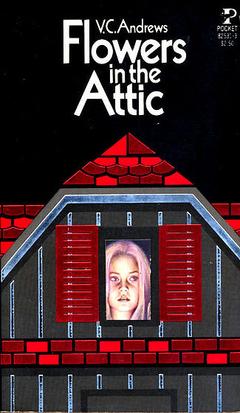Flowers in the Attic

Flowers in the Attic is a 1979 Gothic novel by V. C. Andrews. It is the first book in the Dollanganger Series, and was followed by Petals on the Wind, If There Be Thorns, Seeds of Yesterday, Garden of Shadows, Christopher’s Diary: Secrets of Foxworth, Christopher’s Diary: Echoes of Dollanganger and Christopher’s Diary: Secret Brother. The novel is written in the first-person, from the point of view of Cathy Dollanganger. It was twice adapted into films in 1987 and 2014. The book was extremely popular, selling over forty million copies world-wide.[1]
In 1957, the Dollanganger family—father Christopher, mother Corinne, 14-year-old Chris, 12-year-old Cathy, and 5-year-old twins Carrie and Cory—lives an idyllic life in Gladstone, Pennsylvania until Christopher is killed in a car accident, leaving Corinne deep in debt with no means to support her children.
On the verge of their home being foreclosed, Corinne reveals to the children that as a young woman, her marriage to Christopher so offended her multimillionaire father Malcolm Foxworth that he disinherited her. Now the elderly Malcolm is dying of heart disease, and Corinne intends return to her childhood home of Foxworth Hall in Virginia to win back her father’s affection in time to be reinstated into his will. Because Malcolm is unaware that Corinne had children by her marriage to Christopher, the children must hide in a secluded upstairs room of the enormous Foxworth Hall until Corinne can break the news to her father. She assures the children that they will only be in the room for a few days.
At Foxworth Hall, Corinne’s mother (called only “the grandmother”) locks the children into a bedroom connected to the house’s large attic. The grandmother forces Corinne to reveal the reason for her disinheritance was that Christopher was Malcolm’s younger half-brother, and thus Corinne’s half-uncle, and that the children are the products of incest. The grandmother believes the children are “the Devil’s spawn” and is obsessed with the idea of incest, forbidding all contact between opposite genders, while prohibiting the children from making noise or opening the room’s windows. Only in the attic are they free to play.
Cathy and Chris attempt to make the best of the situation by decorating the attic with paper flowers to create an imaginary garden for the twins. The grandmother comes every morning with a picnic basket filled with the day’s food and interrogates the children about their modesty and piety, questions the children are too innocent to fully understand. Initially their mother visits multiple times per day, bringing toys and gifts, but over time, her visits grow sporadic. After months have passed, Cathy and Chris confront her, as she promised they would be freed in only a few days. Corinne finally confesses that they must remain in the room until their grandfather dies.
A year later, Cathy and Chris have both entered puberty, while the twins are stunted from inadequate nutrition and lack of sunlight. With no other outlets, Cathy and Chris develop a romantic and sexual attraction toward each other, though they do their best to deny their feelings. The grandmother catches Chris staring at a half-dressed Cathy and punishes the children by cutting off their food supply for over two weeks, while the children pray their mother will reappear in time to save them. On the verge of starvation, Cathy and Chris decide to escape with the twins to find help. Before they can go through with the plan, the grandmother begins bringing food again, including a rare treat of powdered sugar doughnuts. Soon afterwards, all the children begin to complain of constant minor illness.
